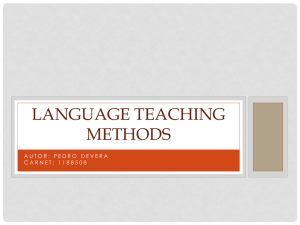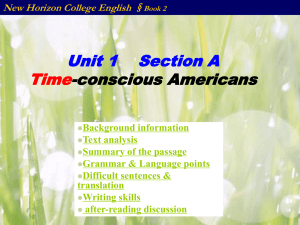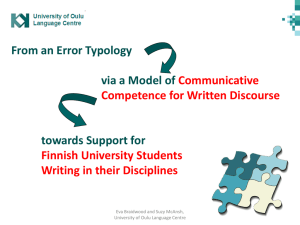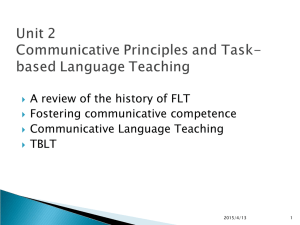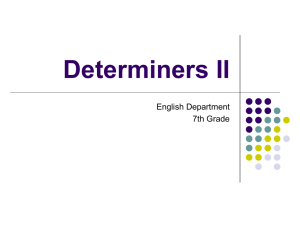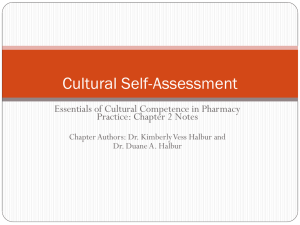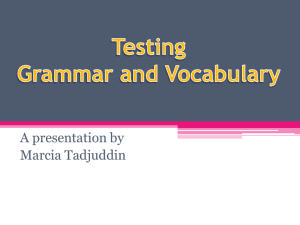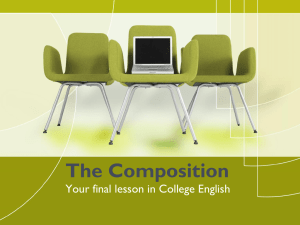The Grammar-Translation Approach
advertisement
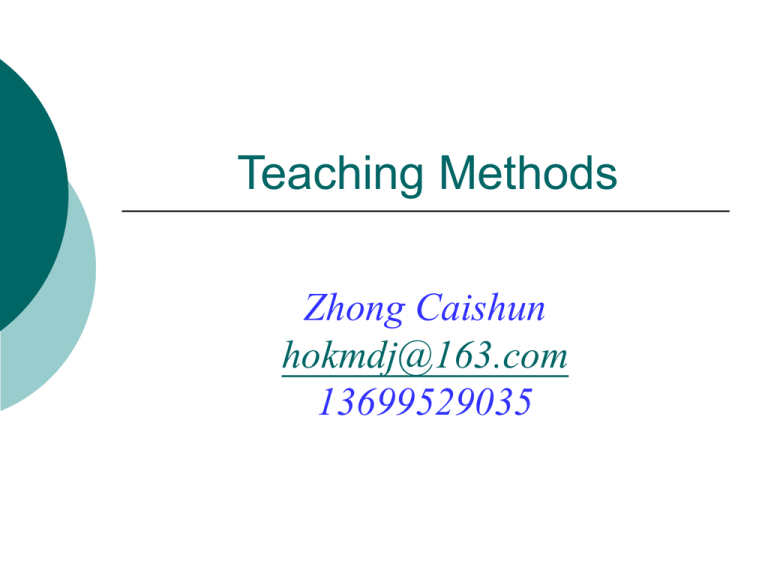
Teaching Methods Zhong Caishun hokmdj@163.com 13699529035 What is the conceptual structure of a teaching method? What are some of the major methods witnessed in the history of language teaching Questions on teaching a language Approach, method, technique Changes in language teaching methods throughout history have reflected recognition of the changes in the kind of proficiency learners need. Approaches and methods Grammar translation Method Direct method Situational/oral Audiolingual The total physical response The silent way Suggestopedia Community language learning The natural approach Communicative approach Task-based language teaching Competency-based instruction Cooperative learning Whole language approach Multiple intelligence Grammar translation method Objectives To be able to read literature written in the target language To be able to translate from one language to another To develop reading and writing skill Principal Characteristics Grammar Translation is a way of learning a language by firstly analyzing its grammar rules, and then applying this knowledge to the task of translating sentences and texts into and out of the target language. Grammar Rules Target Language Translation Reading and writing are the major focus; little or no systematic attention is paid to speaking and listening. Vocabulary selection is based solely on the reading texts used, and words are taught through bilingual word lists, dictionary study, and memorization. The sentence is the basic unit of teaching and language practice. Much of the lesson is devoted to translating sentences into and out of the target language, and it is this focus on the sentence that is a distinctive feature of this method. Principle Characteristics Accuracy is emphasized. Students are expected to attain high standards in translation, because of "the high priority attached to meticulous standards of accuracy which, as well as having an intrinsic moral value, was a prerequisite for passing the increasing number of formal written examinations that grew up during the century" (Howatt 1984: 132, cf. Jack C. Richards & Theodore S. Rodgers, 1986,4). Grammar is taught deductively, that is, by presentation and study of grammar rules, which are then practiced through translation exercises. The student's native language is the medium of instruction. It is used to explain new items and to enable comparisons to be made between the foreign language and the student's native language. ----Richards, J. C., & Rodgers, T. S. (1986). Approaches and Methods in Language Teaching.Cambridge: Cambridge University Press pp.3-4. Application: Typical Techniques (1) (2) (3) (4) (5) (6) (7) (8) (9) Translation of a Literary Passage Reading Comprehension Questions Antonyms/Synonyms Cognates Deductive Application of Rule Fill-in-the-blanks Memorization Use Words in Sentences Composition Shortcomings Wrong idea of what language is Lead to Less learners’ motivation or frustration for learners "a tedious experience of memorizing endless lists of unusable grammar rules and vocabulary and attempting to produce perfect translations of stilted or literary prose." ---from (Richards & Rodgers 1986 p.4). "It is a method for which there is no theory. There is no literature that offers a rationale or justification for it or that attempts to relate it to issues in linguistics, psychology, or educational theory."(ibid.p.5) Advantages of GTM An effective way for application of grammar and sentence structure Few demands on teachers Least stressful for students The Direct Method Background In the late 19th century in Europe, for economic development, the cross-language communication became more frequent. As a result, there was an increasing demand on foreign languages learning and oral communication became the main goal of foreign language teaching. First introduced in France and Germany. Berlitz (Maximilian D. Berlitz,1852-1921) used extensively in Rhode Island, USA, and opened the first language school. Objectives Learn how to communicate in the target language- learn to think in the target language. Correct pronunciation Emphasize listening and speaking. Think in target languages. No native language. No translation. Learning basic sentences, introducing daily life. Rationale of DM First language learning process (1) No grammar (2) No mother tongue (3) No translation (4) Postponement of printed word (5) Postponement of written word Rationale of DM Linguistic theory Strong theoretical base in linguistics and psychology. Language is primarily spoken, not written. The basic unit of a language is sentence. Language is learned through communication. Rationale of DM Learning theory Emphasising vocabulary acquisition through exposure to its use in situations. Meaning is to be conveyed directly in the target language through the use of demonstration and visual aids. Direct communication: as baby learning mother tongue. Imitation: repetition and practice Association: e.g.: hand – arm, shoulder, foot, leg… Grammar is taught inductively: Ss are presented with examples. Teaching model Kelly’s 5 steps of teaching: Preparation: review previous lesson. Presentation: introduce new lesson. Association: associate previous and new lessons. Systematization: systematize the new lesson in certain situation. Application: practice Techniques Reading loud Question and answer exercise Getting students to self-correct Conversation practice Fill-in-the-blank exercise Dictation Map drawing Paragraph writing Role of the teacher/ students Teacher centered. Student role is less passive than in GTM. T/S are partners. Teacher is the only demonstrator. He/she never translates but demonstrates the meaning through the use of realia, pictures or pantomime. Activities–Berlitz School(1) Never translate: demonstrate. Never explain: act. Never make a speech: ask questions. Never imitate mistake: correct. Never speak with single words: use sentences. Never speak too much: make Ss speak much. Activities –Berlitz School(2) Never Never Ss. Never Never Never Never jump around: follow your plan. go too fast: keep the pace of the speak too slowly: speak normally. speak too quickly: speak naturally. speak too loudly: speak naturally. be impatient: take it easy. Advantage of DM An effective way in creating learners to be competent in using the target communicatively. Disadvantage of DM Difficult to implement in public secondary school education Time-wasting Not all teachers were proficient enough in the foreign language Oral-Situational Approach Developed in Britain and popular between the 1930s and 1960s Main difference between DM and OSA Oral-Situational Approach has a systematic planed vocabulary and grammar rules, DM hasn’t. Main difference between ALM &OSA Oral-Situational Approach doesn’t mention about reinforcement, ALM does. Purpose Teaching a practical skill of L2 through copy the way children acquire L1 Characteristic ˙Start from spoken language ˙Avoid errors ˙Teacher-centered ˙Focus on Listening and speaking ˙Chosen the vocabulary ˙The first method uses structural syllabus Typical Procedure ˙Teacher gave a topic ˙Demonstrate with teaching aids ˙Key word changed Advantages with using OSA ˙Bring the reality situation in the classroom ˙Scheduled progress Disadvantages with using OSA ˙Turn students into parrots ˙Boring and mindless ˙Reduce the motivation The Audiolingual Method ˙Founded during World War II for military purposes in USA ˙Popular in the 1960s but died out in the 70s Audiolingual Objective Teaching model Stimulus-response-reinforcement model (imitation, patterned drilling, substitution) Language and Learning theory Focus on students’ pronunciation, and train their ability of listening by dialogues and drills Structuralism/Behaviorism Role of the teacher and students The controller and the controlled An example Teaching procedures (1)hear a dialogue (2)repeat the dialogue (3)key words or structures changed (4)practice substitutions in the pattern drills Features (1) Imitation (2) repetition (3) Positively reinforced (4) Over learn *Emphasize in the “Form”, not the “Meaning” Criticism Disadvantages It fails to address the context and function of language. It banish all forms of language processing that help students sort out new language information in their own minds. Turn Students into parrots Boring and mindless Reduce the motivation advantages Allows Students to communicate quickly Students became good at pattern Total Physical Response/TPR (James Asher , 1966) founded by James Asher, a professor of psychology at San José State University, California, USA The Purpose To have basic oral expression ability through using imperative sentences. The Characteristic (1)retention (2)Direct commands (3)No stress (4)Listen first *Emphasize in the “Meaning”, not the “Form” Typical Procedure in a TPR Course (1)input (2)comprehension (3)express Advantages with using TPR ˙Fun. ˙Memorable. ˙Good for kinesthetic learners. ˙No matter the class size. >>> Advantages with using TPR ˙Work well with mixed-ability classes. ˙No requirement for many preparation or materials. ˙Effective with young learners. ˙Involves both left and right-brained learning Disadvantages with using TPR ˙Students feel shy ˙Less useful for upper levels ˙overuse TPR The silent way Background In the 1960s, both Behaviorism (psychological foundation) and Structuralism (linguistic foundation) were attacked by linguists and psychologists. Behaviorism was followed by Cognitive Psychology. Structuralism was followed by Transformational-generative linguistics. Theoretical foundation Transformational generative grammar: Language learning is not the outcome of habit formation (Behaviorism). It is the process of creative rule formation or discovery. Theory internalized grammar of a language – Competence – enables one to create and understand totally new sentences. Cognitive psychology Human is creative, so mimicry, memorization, repetition and parrot learning (Behaviorism) do not lead to real learning Features of SW All four skills are worked on from the beginning. In addition. Form and meaning are both important. It assigns an active role to the learner. The teacher goes from familiar to unfamiliar. For example, he starts with L2 sounds which are similar to L1 sounds. Features of SW The teacher speaks very little, only when needed. His silence motivates the learners to participate more and be active. The teacher is not the model. His gestures work. Student’s “self criteria” for correctness are emphasized. The student takes the responsibility of learning. Students’ actions show if they have learned. Students help each other. The teacher uses gestures and L1 to help them learn. Students’ familiar knowledge (old context) helps them learn the unfamiliar (new context). The teacher’s interference is very little. Features of SW Meaning is achieved through perceptions (senses), not translation. Group cooperation is the norm. Little praise and punishment. Errors are important. They are the road signs. Self correction over teacher’s correction. Students listen to each other. Learning rates are different. Perfection is not the target. The teacher frees his time by his silence. Students are attentive. Meaningful practice is preferred to repetition. Logical presentation of language elements from familiar to unfamiliar. Features of SW Autonomy is gained by exploring and making choices. Feedback from students informs the teacher. No homework:sleeping practice Syllabus is structure based. Structures are not presented in a linear way. Skills (speaking, reading and writing) reinforce one another. Suggestopedia The name is from the words suggestion and pedagogy. Developed in the 1970s by the Bulgarian psychologist Georgi Lozanov Attention and memory studies (Adapted from: Richards & Rodgers 2001 Approaches & Methods in Language Teaching Cambridge) Purpose Desuggest the psychological barriers to learn vocabulary and conversation Characteristics ˙Present text with music ˙Practiced breathing ˙Comfortable ˙Choose target language name ˙Colorful posters on the wall ˙Liberate instead of teach Elements to Suggestopedia ˙Authority: people remember best and are most influenced by information coming from an authoritative source ˙Infantilization: authority is also used to suggest a teacherstudent relation like that of parent to child. In the child's role the learner takes part in role playing, games, songs, and gymnastic exercises that help "the older student regain the self-confidence, spontaneity, and receptivity of the child." ˙Double-planedness: The learner learns not only from effect of direct instruction but from the environment in which the instruction takes place (e.g. classroom decoration, music, shape of charts, teacher's personality) ˙Intonation, Rhythm and concert pseudo-passiveness: Both intonation and rhythm are coordinated with a musical background. The musical background helps to induce a relaxed attitude, which Lozanov refers to as concert pseudopassiveness The type of music is critical to learning success: Lozanov recommends a series of slow movements (sixty beats a minute) in 4/4 time for Baroque concerto (strung together into a half-hour concert) The body relaxed, the mind became alert Typical Procedure ˙Deciphering ˙Concert session ˙Elaboration ˙Production Advantages with using Suggestopedia ˙Increase oral proficiency ˙Lower classroom anxiety Disadvantages with using Suggestopedia ˙Unavailable of music and comfortable chair ˙No advanced comprehension technique Community Language Learning Developed by Charles Curran and his associates in 1970s Comparison Psychological Requirements for Successful Learning ˙S stands for security ˙A stands for attention and aggression ˙R stands for retention and reflection ˙D represents discrimination Purpose The teacher can successfully transfer his or her knowledge and proficiency in the L2 to the students; Specific purposes are not mentioned. Characteristics ˙Client-Counselor and LearnerKnower relationships ˙Humanistic Techniques ˙Code Alternation Advantages with using CLL ˙Remove the feeling of distance and insecure ˙Counselor allows the learner to decide the topic Disadvantages with using CLL ˙Teacher may become too indirective ˙Confidence based on an inductive strategy for learning Typical Procedure ˙Translation ˙Group Work ˙Recording ˙Transcription ˙Analysis ˙Reflection and observation Main Steps of Procedure of CLL ˙Investment ˙Reflection The Comprehension-based Approach (Natural Approach) •The Natural Approach was developed by Tracy Terrell and Stephen Krashen, starting in 1977. It came to have a wide influence in language teaching in the United States and around the world. Features of NA Listening comprehension is very important Begin by listening to meaningful speech Speak when ready One step beyond their level of competence Error correction Appropriate input for the learners Adopt freely from various method sources The NA v.s. The DM The NA emphasize on 1.Exposure / input 2.Optimizing emotional preparedness 3.A prolonged period of hearing The DM emphasize on 1.Teach monologue 2.Direct repetition 3.Formal Q/A 4.Accurate production Objectives of NA To be able to function adequately in the target situation. To be able to convey their requests and idea Teacher and Student Roles Teacher Roles The primary source Create a classroom atmosphere Choose a rich mix of classroom activities Student Roles Participator ; responder The Communicative Approach Hymes’ view of communicative competence (1979) formally possible (grammatically acceptable) understandable to human beings in line with social norms in fact done: Do people actually use language this way? Canale and Swain’s Four dimensions of communicative competence (1980) Grammatical competence Sociolinguistic competence Discourse competence Strategic competence (Richards & Rodgers, 1986:71) Hedge’s five main components of communicative competence (2000) Linguistic competence Pragmatic competence Discourse competence Strategic competence Fluency Theory of Learning the communication principle: Activities that involve real communication promote learning. the task principle: Activities in which language is used for carrying out meaningful tasks promote learning (Johnson 1982). the meaningfulness principle: Language that is meaningful to the learner supports the learning process. (P20) Features of CA Communicative intent The use of authentic materials Activities are often carried out Major Classroom Activities Activities Precommunicative activities Communicative activities Classification Structural activities Quasicommunicative activities Functional communication activities Social interaction activities Functions Primary focus on linguistic forms Focus on forms plus meanings Focus on meanings plus forms Primary focus on meanings Teacher and Student Roles Teacher roles (1) To facilitate communication (2) To be a co-communicator Student roles Communicator Advantages of the CA (1) Students will be more motivated (2) Students have opportunities to express (3) Student security is enhanced Disadvantages of the CA No environment of ESL Difficulty in evaluating students’ performance Ignore the training of reading and writing Typical techniques Authentic materials Scrambled sentences Language games Picture strip story Role play Task-based language teaching Competency-based instruction Cooperative learning Whole language approach Multiple intelligence

